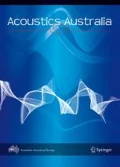Abstract
Controlling freight rail noise at-source can be more effective than seeking to treat either the noise path or the receiver. This paper presents a framework for at-source noise control of freight rail noise. This framework is discussed in the context of the complete system through which the noise is generated, and explained through a case study focused on curve squeal. The application to curve squeal includes considerations of the track, the wheel–rail interface and the rolling stock. It is shown how addressing each system in parallel can not only mitigate curve squeal, but can also lead to the more efficient operation of the railway. Other primary freight rail noise sources are also discussed, and opportunities for addressing these impacts through the proposed noise control framework are outlined. These include locomotive exhaust noise, locomotive idling noise, brake squeal and bunching/stretching noise.









Similar content being viewed by others
Notes
The sign convention of the TBOGI system is such that negative AoA denotes wheels attacking the high rail of the curve, i.e. the outside of the curve.
Tracking position measures the position of the wheelset relative the track centre line. Negative tracking position denotes wheels that are pushing towards the outside/high rail of the curve.
Bogie warp is defined as the angle between the side frame and the bolster, which should be zero if the bogie remains square. Refer to Fig. 8 for an overview of bogie components.
Hunting is a resonant yaw vibration of the bogie that typically occurs at high speeds and limits the top service speed of the wagon.
References
Thompson, D.: Railway Noise and Vibration: Mechanisms, Modelling and Means of Control. Elsevier, Oxford (2009)
Power, G., Taylor, E.: Optimising wheel life in New South Wales using Olympic Park Loop as a wheel/rail interface test site. In: CORE2002, RTSA (2002)
Hanson, D., Jiang, J., Dowdell, B., Dwight, R.: Curve squeal: causes, treatments and results. In: Internoise 2014, Melbourne (2014)
Anderson, D.: Wheel squeal measurement, management and mitigation on the New South Wales rail network. In: Acoustics 2004, Gold Coast (2004)
Wayside Inspection Devices: TBOGI Bogie Condition Monitor, [Online]. Available: http://www.wid.ca/products/tbogi
Jiang, J., Anderson, D., Dwight, R.: The Mechanisms of curve squeal. In: IWRN11, Uddevalla (2013)
Jiang, J., Ying, I., Hanson, D., Anderson, D.C.: An investigation of the influence of track dynamics on curve noise. Notes Numer. Fluid Mech. Multidiscip. Des. 126, 441–448 (2015)
Curley, D., Anderson, D., Jiang, J., Hanson, D.: Field trials of Gauge face lubrication and top-of-rail friction modification for curve noise mitigation. Notes Numer. Fluid Mech. Multidiscip. Des. 126, 449–456 (2015)
International Heavy Haul Association: Best practice for heavy haul railway operations (wheel and rail issues), International Heavy Haul Association (2009)
American Railway Engineering and Maintenance-of-Way Association: Track. In: Manual for Railway Engineering, American Railway Engineering and Maintenance-of-Way Association, Maryland (2015)
British Standards Institute, BS EN 16028:2012 Wheel/rail friction management: lubricants for trainborne and trackside applications, British Standards Institute (2012)
British Standards Institute: BS EN 15427:2008 railway applications. Wheel/rail friction management, British Standards Institute (2008)
RailCorp: ESC220 Rail and rail joints, Asset Standards Authority (2013)
Uddin, M.G., Chattopadhyay, G., Sroba, P., Rasul, M., Howie, A.: Wayside lubricator placement model for heavy haul lines in Australia. In: Conference on Railway Engineering, 2010 (2010)
Asset Standards Authority: T HR TR 00111 ST Rail Lubrication, Asset Standards Authority, Sydney (2015)
Standard Car Truck Company: Standard Car Truck Company, [Online]. Available: http://www.sctco.com/pdf/fullmanual.pdf. Accessed 16 June 2015
Association of American Railroads: Lubrication manual. In: Manual of standards and recommended practices section H-III, pp. S-730. Association of American Railroads, Washington, DC (2011)
Wickens, A.H.: Fundamentals of Rail Vehicle Dynamics: Guidance and Stability. Swets & Zeitlinger Publishers, Lisse (2003)
Interfleet Technology: Vampire Wheel Wear Study, TfNSW - internal report (2014)
Interfleet Technology: Fuel Saving Simulation, TfNSW - internal report (2015)
Acknowledgments
Much of the work described in this paper has been undertaken by TfNSW in partnership with freight operators and rail infrastructure maintainers. We would like to thank all those involved from Sydney Trains, ARTC, Pacific National, Southern Shorthaul Railroad, SCT Logistics and Aurizon for their contributions and celebrate the collaborative approach the rail industry is taking to addressing noise.
Author information
Authors and Affiliations
Corresponding author
Rights and permissions
About this article
Cite this article
Jiang, J., Hanson, D. & Dowdell, B. At-Source Control of Freight Rail Noise: A Case Study. Acoust Aust 43, 233–243 (2015). https://doi.org/10.1007/s40857-015-0026-3
Received:
Revised:
Accepted:
Published:
Issue Date:
DOI: https://doi.org/10.1007/s40857-015-0026-3




